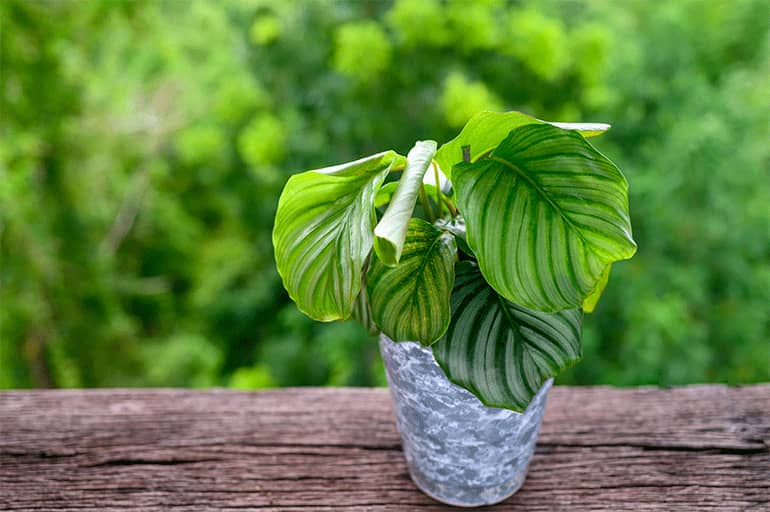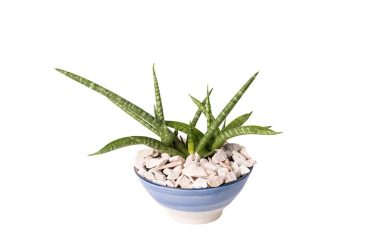Would you love to think of you as a nature enthusiast and your heart is set on decorating your interior with gorgeous and exotic plants, Calathea Orbifolia Air Purifier Plant is a perfect choice. This low-maintenance plant has an appealing ornamental outlook, leaving you mesmerized with its rich and vibrant leaves. It definitely spreads its charisma in every interior of your house or office. The plant plays a good role in maintaining a healthy and high-spirited inner climate.
What is a Calathea Orbifolia Air Purifier Plant?
Calathea plants are scientifically named Marantaceae. Choose a corner to place this plant where direct sunlight is not reflected. Indirect lighting favors this plant, considering its roots. These species originate from tropical areas. They mostly develop in areas of low light, like the base of trees and in jungles. These plants do not survive well in direct sunlight. Other than its artistic and pleasing visuals, this spectacular plant cleanses the surrounding air. This ensures the admirers of this extravagance are always healthy!
Botanical name | Calathea |
| Common name | Zebra plant, rattlesnake plant, peacock plant |
| Plant type | Herbaceous perennial |
| Mature size | 6 in.–3 ft. tall, 6 in.–2 ft. wide |
| Sun exposure | Partial sunlight, full shade |
| Soil type | Moist but well-drained |
| Soil pH | Acidic |
| Bloom time | Summer |
| Flower color | Yellow, purple, white |
| Hardiness zones | 11, 12 (USDA) |
| Native area | South America |
| Toxicity | Non-toxic |
What is Calathea Orbifolia Air Purifier Plant?
Apart from the charismatic appearance of Calathea Orbifolia Air Purifier Plant, it purifies the air around it. The plant filters harmful elements. This contributes to a healthier indoor climate of your habitat.
Advantages of Calathea Orbifolia Air Purifier Plant
- Disinfects the air around the plant
- Visually pleasing and decorative
Disadvantages of Calathea Orbifolia Air Purifier Plant
- These plants mostly filter the air with a high moisture level which is why the rooms need to have well air ventilation. Thus, opening windows for 15 minutes daily, especially during winter is vital.
- The plants form browning tips if they do not get proper humidity.
- Watering the soil by dipping the pot in water is important to avoid fungus.
Required Items to grow Calathea Orbifolia Air Purifier Plant
These plants do not perform well in areas under direct sunlight. Safeguarding the leaves from direct sunlight is one of the vital factors for good growth.
Water the plant enough to keep the soil damp. However, too much watering can also lead to unwanted results. On the other hand, a long duration of leaving the plant dry will cause the leaves to form brown leaf tips. This is visually unpleasing and sort of destroys the fundamental purpose of the plant.
This plant prefers humidity.
One more crucial piece of information about this plant is that it is not recommended for human or animal consumption.
1. Required Sunlight and Temperature
The plant Calathea originates from the rainforest of South America. Basing upon its origin this plant is called a semi-shade plant. The temperature these plants grow in ranges from 16 and 27 °C.
This decorative plant looks amazing on a dimly lit corner of any room.
2. Humidity
Mild temperatures are best to have your plant thriving. Experts recommend choosing a spot that is sunlight cannot reach directly, yet the spot is airy. Refrain from keeping your plants around crispy weather.
The humidity level can be manually adjusted by using a humidifier. Another DIY way of keeping your plants humid is to fill up the pots with pebbles of different sizes. This prevents the plant from sinking in. which causes the water to evaporate. This ultimately keeps the air around the plant humid.
3. The potting medium of calathea
This plant appreciates moist soil. The standard and the best mixture of the soil is 50% potting soil, incorporated with 20% orchid bark, blended with 20% charcoal, and finally 10% perlite.
4. Plastic or terra cotta- the better choice
Botanists have debated on this for a long time. Both parties have valid arguments. However, the final conclusion stands that terra cotta removes the excess moisture. This leaves the soil moist. Although, if you are an inhabitant of a dry area, plastic pots are the better choice.
5. What type of soil is best for Calathea Orbifolia Air Purifier Plant?
Moisture is the uttermost element of the soil that a Calthea plant grows in. you should go for an option where the soil retains water well. However, ensure the pot has a good drainage system. Waterlogged roots are harmful to the plant.
These plants opt for slightly acidic soil, which has a pH of around 6.5.
6. Soil Prepare with Organic Fertilizer
Experts suggest treating your plant with liquid fertilizer. For satisfying and positive outcomes, you should continue this practice throughout the year, once every month.
Maintenance and Care for Calathea Orbifolia Air Purifier Plant
Calathea Orbifolia Air Purifier Plant has always been in popular demand as an indoor plant. as they are comparatively easier to care for. They can be planted in a wide range of locations. However, some of the key requirements of this plant include-
-
Watch out for direct sunlight
these plants need bright sunlight to bloom. But direct sunlight can be harmful to them. Mainly because they originate from the deep rainforest of South America. They grow on the basis of trees. Therefore, they are exposed to very little or no sunlight. As a matter of fact, the leaves calathea plant lose their vibrant color if they are exposed to direct sunlight for an extended period.
-
Watering the plant
Keeping the soil moist is crucial to ensure the full growth of the plant. However, we do not want waterlogged or soggy roots. Thus, watering the plant just the right amount is vital. Use distilled and chemical-free water to water the soil of the plant.
-
Temperature
These plants do not admire the cold weather. This is quite obvious, given where they originate from. They are from tropical dense forests and are well suited in temperatures ranging from 65 to 80 degrees. Being in too hot or too cold weather can have a negative effect on the plant.
-
Humidity
As mentioned earlier, these plants prefer to be in humid conditions.
-
Fertilizers that need to be used
These plants do not need much fertilizer. But with a little bit of liquid fertilizer, they bloom well. They need fertilizers during summer, fall and spring mainly.
-
Pruning
The greatest catch of these plants is that they do not need pruning. Other than the tips of their leaves turning brown.
Frequently asked questions (FAQs) On Calathea Orbifolia Air Purifier Plant
Q1. Why do Calathea leaves turn brown?
Ans. There are two possible reasons why the leaves turn brown. It happens when the plant is not watered enough. Another reason is too much usage of fertilizers. An easy solution to avoid this is to cut down on fertilizers and making sure the soil receives an adequate amount of water.
Q2. Why are my Calathea leaves are curling?
Ans. The curling of Calathea’s leaves happens due to a lack of moisture in the soil. This can be avoided by watering regularly. Although be careful the roots are not waterlogged.
Q3. Why are Calathea Orbifolia Air Purifier Plant leaves yellowing?
Ans. The leaves turning yellow is an indication of water too much. If you notice this happening, inspect the soil. Check if the roots are too sloppy. If that is the case, water the plant less.
The Joy of Calatheas
The combination of vibrant and bright green leaves with emboldened patterns makes for as pretty as a picture display. This is not only an amazing and exclusive decorative piece but also creates a healthier and cleaner environment.





